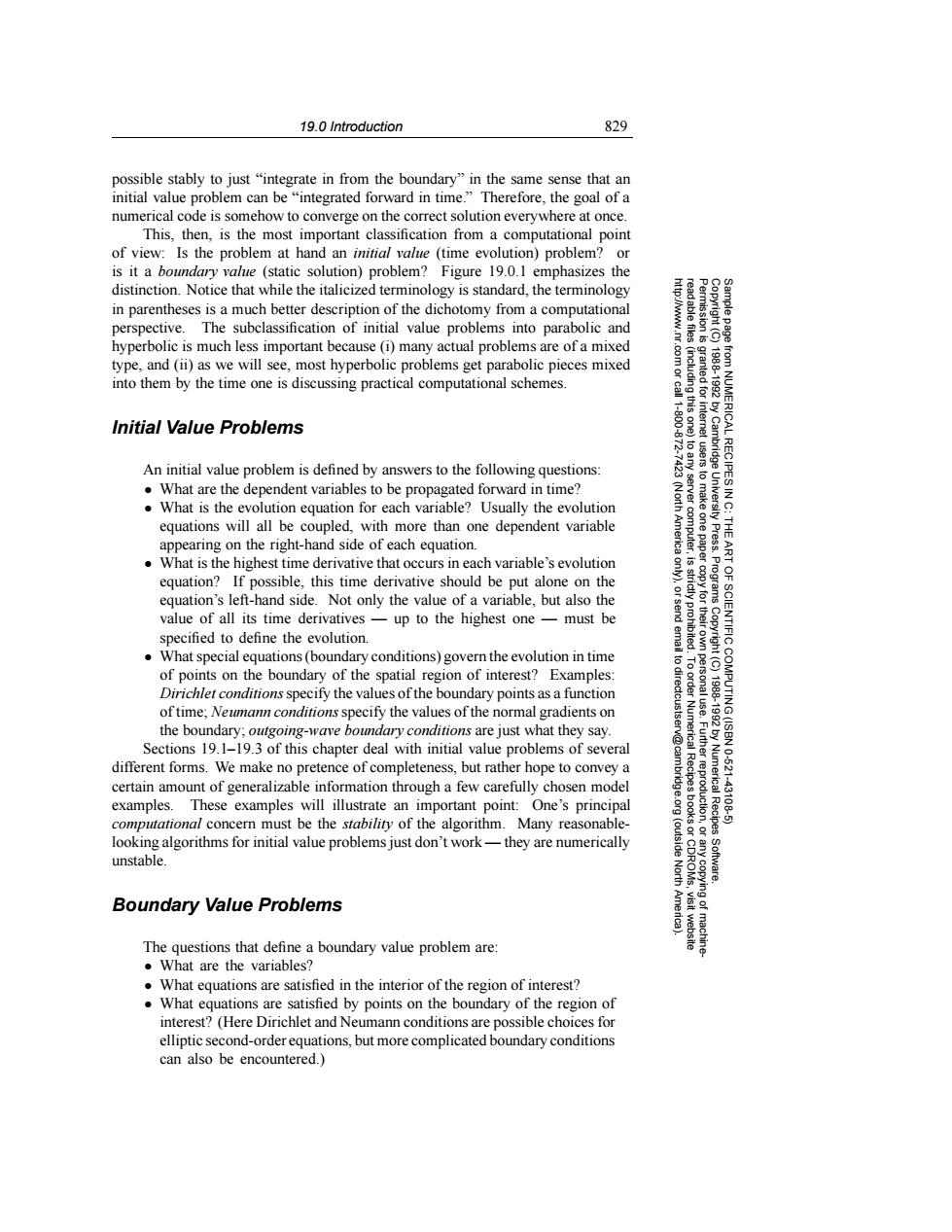正在加载图片...

19.0 Introduction 829 possible stably to just"integrate in from the boundary"in the same sense that an initial value problem can be"integrated forward in time."Therefore,the goal of a numerical code is somehow to converge on the correct solution everywhere at once. This,then,is the most important classification from a computational point of view:Is the problem at hand an initial value (time evolution)problem?or is it a boundary value (static solution)problem?Figure 19.0.1 emphasizes the distinction.Notice that while the italicized terminology is standard,the terminology in parentheses is a much better description of the dichotomy from a computational perspective.The subclassification of initial value problems into parabolic and hyperbolic is much less important because(i)many actual problems are of a mixed type,and(ii)as we will see,most hyperbolic problems get parabolic pieces mixed into them by the time one is discussing practical computational schemes. Initial Value Problems An initial value problem is defined by answers to the following questions: What are the dependent variables to be propagated forward in time? What is the evolution equation for each variable?Usually the evolution equations will all be coupled,with more than one dependent variable appearing on the right-hand side of each equation. What is the highest time derivative that occurs in each variable's evolution equation?If possible,this time derivative should be put alone on the equation's left-hand side.Not only the value of a variable,but also the Programs value of all its time derivatives-up to the highest one-must be specified to define the evolution. .What special equations(boundary conditions)govern the evolution in time 、兰三猴 of points on the boundary of the spatial region of interest?Examples. to dir Dirichlet conditions specify the values of the boundary points as a function of time;Neumann conditions specify the values of the normal gradients on the boundary;outgoing-wave boundary conditions are just what they say. Sections 19.1-19.3 of this chapter deal with initial value problems of several different forms.We make no pretence of completeness,but rather hope to convey a 10621 certain amount of generalizable information through a few carefully chosen model examples.These examples will illustrate an important point:One's principal Fuurggoglrion Numerical Recipes 43108 computational concern must be the stability of the algorithm.Many reasonable- looking algorithms for initial value problems just don't work-they are numerically (outside unstable Software. Boundary Value Problems ying of The questions that define a boundary value problem are: What are the variables? What equations are satisfied in the interior of the region of interest? What equations are satisfied by points on the boundary of the region of interest?(Here Dirichlet and Neumann conditions are possible choices for elliptic second-order equations,but more complicated boundary conditions can also be encountered.)19.0 Introduction 829 Permission is granted for internet users to make one paper copy for their own personal use. Further reproduction, or any copyin Copyright (C) 1988-1992 by Cambridge University Press. Programs Copyright (C) 1988-1992 by Numerical Recipes Software. Sample page from NUMERICAL RECIPES IN C: THE ART OF SCIENTIFIC COMPUTING (ISBN 0-521-43108-5) g of machinereadable files (including this one) to any server computer, is strictly prohibited. To order Numerical Recipes books or CDROMs, visit website http://www.nr.com or call 1-800-872-7423 (North America only), or send email to directcustserv@cambridge.org (outside North America). possible stably to just “integrate in from the boundary” in the same sense that an initial value problem can be “integrated forward in time.” Therefore, the goal of a numerical code is somehow to converge on the correct solution everywhere at once. This, then, is the most important classification from a computational point of view: Is the problem at hand an initial value (time evolution) problem? or is it a boundary value (static solution) problem? Figure 19.0.1 emphasizes the distinction. Notice that while the italicized terminology is standard, the terminology in parentheses is a much better description of the dichotomy from a computational perspective. The subclassification of initial value problems into parabolic and hyperbolic is much less important because (i) many actual problems are of a mixed type, and (ii) as we will see, most hyperbolic problems get parabolic pieces mixed into them by the time one is discussing practical computational schemes. Initial Value Problems An initial value problem is defined by answers to the following questions: • What are the dependent variables to be propagated forward in time? • What is the evolution equation for each variable? Usually the evolution equations will all be coupled, with more than one dependent variable appearing on the right-hand side of each equation. • What is the highest time derivative that occurs in each variable’s evolution equation? If possible, this time derivative should be put alone on the equation’s left-hand side. Not only the value of a variable, but also the value of all its time derivatives — up to the highest one — must be specified to define the evolution. • What special equations (boundary conditions) govern the evolution in time of points on the boundary of the spatial region of interest? Examples: Dirichlet conditionsspecify the values of the boundary points as a function of time; Neumann conditionsspecify the values of the normal gradients on the boundary; outgoing-wave boundary conditions are just what they say. Sections 19.1–19.3 of this chapter deal with initial value problems of several different forms. We make no pretence of completeness, but rather hope to convey a certain amount of generalizable information through a few carefully chosen model examples. These examples will illustrate an important point: One’s principal computational concern must be the stability of the algorithm. Many reasonablelooking algorithms for initial value problems just don’t work — they are numerically unstable. Boundary Value Problems The questions that define a boundary value problem are: • What are the variables? • What equations are satisfied in the interior of the region of interest? • What equations are satisfied by points on the boundary of the region of interest? (Here Dirichlet and Neumann conditions are possible choices for elliptic second-order equations, but more complicated boundary conditions can also be encountered.)